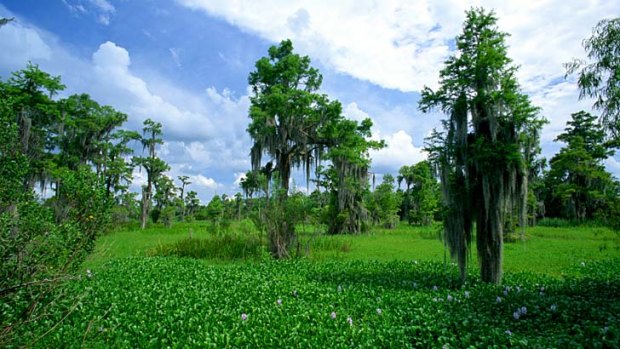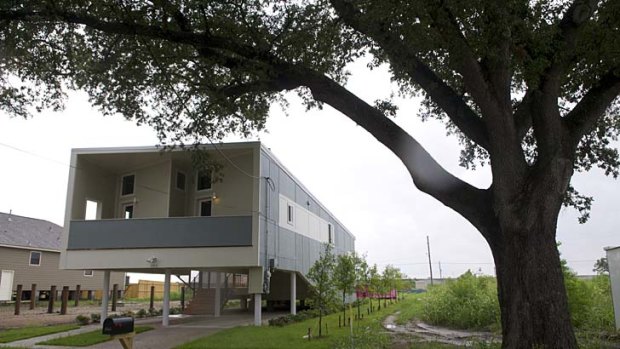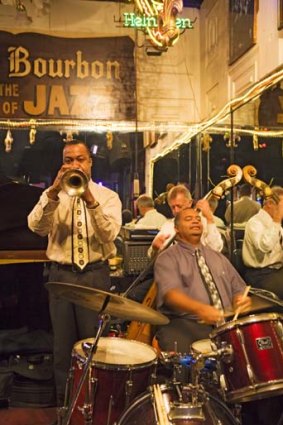
Gators and turtles galore ... Jean Lafitte National Historic Park and Preserve.Credit: Alamy
From seeing how hurricane-ravaged suburbs are rebuilding to an up-close look at basking alligators, New Orleans has a tour for just about everybody, writes Katrina Lobley.
When it comes to unusual tours, New Orleans - pronounced New 'awlins, y'all - is hard to beat. Voodoo tour in a cemetery? Check. Cocktail walking tour through the French Quarter? Check. Pirates, paddle steamers or plantations? Check, check, check.
Yet of all the tours on offer, the Hurricane Katrina one piques my interest most. It's almost seven years since that disaster unfolded so spectacularly and awfully across our TV screens, but I still feel like a voyeur signing up for it. I don't expect it to be popular but in fact I snaffle the last ticket on today's minibus.

An example of Brad Pitt's 16-block housing project in the Lower Ninth Ward.Credit: AFP
The three-hour tour takes off from the Gray Line ticket office sandwiched between the Mississippi River and the French Quarter, where tourists can easily forget that Katrina devastated the rest of the city on August 29, 2005. The hurricane generated a storm surge that breached the levees in more than 50 places, flooding 80 per cent of New Orleans.
As the bus starts its 80-kilometre circuit around the city, we pass a poignant memorial near the Convention Centre: Scrap House, a sculpture created from Katrina debris, depicts a wrecked shack stranded up a tree. We don't stop or get off to take pictures - the bus just keeps moving as it does for the entire tour, except for a refreshment break among the Spanish moss-draped oak trees of City Park. We whiz along an expressway, past that infamous Superdome where all veneer of civilisation fell away after the disaster as the stranded waited there for help. Last year, in an odd marketing move, it was renamed the Mercedes-Benz Superdome.
Out in suburbia we see rebuilt houses that meet - and sometimes exceed by a long shot - new elevation standards, along with a patchwork of vacant lots. Heartbreaking "for sale" signs read "$25,000 or best offer" for these lots that have had blighted homes demolished and removed.
I'm glad for the insight into what's unfolded.
Our guide, Michael, reels off unsettling figures. Pre-Katrina, New Orleans had 485,000 residents; today, there are only about 340,000 - a 30 per cent slump. That's meant a lot of schools, hospitals, shopping centres, fire stations - in fact, every service you can think of - have never reopened. Even a theme park on the city outskirts stands abandoned.
A few houses are still marked with the spray-painted symbols left behind by rescuers who searched for survivors or bodies and recorded their findings on the front wall in chilling shorthand; some houses still have "chop-outs" in their roofs through which rescuers pulled stranded residents from attics.
Gray Line, which has run tours in New Orleans since 1924, started this one in January 2006 - when emotions were still raw, the misery unrelenting and the city barely functioning. It was criticised for running a "disaster tour". The company's position is that the tours are educational, allowing visitors to see how the city is rebuilding and what engineering efforts have been made to ensure such disaster never strikes again.

Maison Bourbon on Bourbon Street in the French Quarter is a hot spot for jazz music.Credit: Getty Images
"Our city can be an inspiration to others where people have lost their homes to flood, fire or disaster," Michael says. "It's quite a story."
Still, it's hard not to feel like we're gawking as we cruise through what's known as the "Brad Pitt development" in the Lower Ninth Ward. The actor has committed to building 150 eco-friendly, flood-proof homes over 16 blocks; the project is just over the halfway mark. Residents of the angular, architecturally intriguing homes are sitting on their porches or going about their day-to-day business as we peer at them through the tinted bus windows.
Pitt's not the only celebrity helping to restore the devastated neighbourhoods. The saxophonist Branford Marsalis and the crooner Harry Connick jnr have created a "musicians' village" in the Upper Ninth Ward, helping Habitat for Humanity to build 77 low-cost homes for the musicians who give New Orleans its famously steamy, sensual swagger.
As I return to the French Quarter, where the good times roll on and on each night in the clubs that line Bourbon Street and nearby Frenchmen Street, I'm hit with a new feeling: I'm glad for the reality check and insight into what's unfolded beyond the borders of the tourist district.
Next day, after a very New Orleans breakfast of beignets (piping-hot square doughnuts smothered in icing sugar) and cafe au lait, I'm venturing further afield. The swamp and bayou boat tour is a peaceful glide through back-country canals bordering the Jean Lafitte Preserve, south of the city.
Two girls, aged three and six, take great delight counting the 'gators and turtles sunning themselves on logs or sliding through the shallow waters. They give up after spotting eight of each within minutes, and ask Captain Brent: "Where are the monkeys?""You're on the wrong tour," he deadpans in reply.
The banks are a tangle of dwarf palmetto, cypress and Spanish moss; invasive water hyacinth adds pretty purple patches to the mirror-like waterways. And although this is a long way from Hollywood, there's a touch of celluloid in a cabin facade erected on the banks for a Burt Reynolds thriller I've never heard of (2001's Tempted).
Of course, there's an opportunity to cuddle a 'gator.
Captain Brent brings out a baby beast named Godzilla to pass around, though not before he tapes its mouth shut. After all, he's too busy navigating and talking to dispense 'gator aid as well.
The writer travelled courtesy of Creative Holidays and the New Orleans Convention and Visitors Bureau.
Trip notes
Getting there
Qantas flies daily to Dallas-Fort Worth, and partner American Airlines connects to New Orleans.
Staying there
Omni Royal Orleans, at the corner of St Louis and Royal streets, is centrally located in the French Quarter and features a rooftop pool, bar and viewing platform. Rooms start from $92 a person a night, twin share, through Creative Holidays.
Touring there
The Hurricane Katrina tour costs $US48 ($47) adult, $US30 child; the half-day swamp and bayou tour costs from $55 adult/$27 children, through Creative Holidays. graylineneworleans.com, creativeholidays.com.
More information
Sign up for the Traveller Deals newsletter
Get exclusive travel deals delivered straight to your inbox. Sign up now.